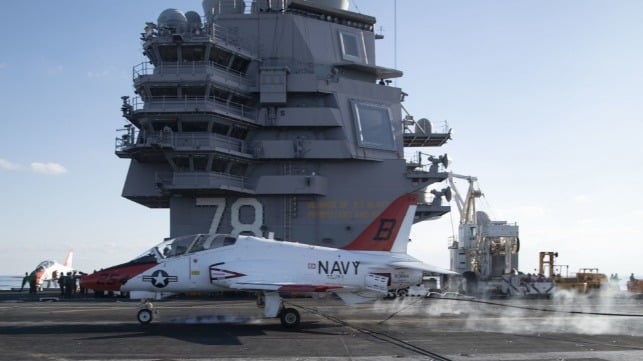Report: Navy's Costliest Carrier Cannot Reliably Launch Fighters

The troubled first-in-class aircraft carrier USS Gerald R. Ford is still unable to launch and recover fighters with anywhere near the reliability required for operations, according to a draft report produced by the Pentagon's director of operational testing and evaluation. The report - obtained and first reported by Bloomberg - echoes the office's earlier concerns about the Ford-class carrier, and it suggests that little has improved for the vessel's futuristic launch and recovery systems.
Over the course of 3,975 launches from November 2019 through September 2020, Ford's electromagnetic launch system (EMALS) averaged about 180 cycles between operating failures, suggesting more than 20 failures within a year. Two of these failures took down the system for three days for repairs, according to the report. The Navy's design requirement for EMALS calls for 4,166 cycles between failures.
The Ford's advanced arresting gear (AAG) - which catches and slows down planes on landing - fared even worse, averaging less than 50 cycles between failures. An additional breakdown during a pierside maintenance period took the crew a full week to fix.
The USS Ford cost $13.1 billion to build and commission - enough to purchase about 10 FFG(X) future frigates. She is easily the most expensive warship ever built, and may well be a contender for the title of most expensive vessel of any kind.
Despite unprecedented expenditures and many years of delay, the work to bring her up to initial operational capability is not yet finished. She was originally slated to come online for duty in 2018, but that date has been pushed back to 2023-24. Her electromagnetically-actuated weapons elevators, which are the only way to deliver munitions from belowdecks to the flight deck, were non-functional at the time of delivery and are still not complete. Only six out of 11 have been commissioned.
Additionally, USS Ford was delivered without the required facilities to accommodate the Navy's new stealthy fighter, the F-35C, and at present she can only deploy with the capable but non-stealth F/A-18 Hornet. The second-in-class USS John F. Kennedy was also built without F-35 capability, and the Navy is putting effort into retrofitting Kennedy first.
The Pentagon has already committed to buy four hulls in the Ford series - USS Ford, USS Kennedy, USS Enterprise and USS Dorris Miller. The last two hulls were purchased in a block-buy in order to reduce cost. USS Ford has been delivered, and construction on USS Kennedy and USS Enterprise is under way.
Last March, then-Acting Secretary of the Navy Thomas Modly said that the service might leave the series at four hulls and skip purchasing another six planned vessels. "I don’t know if we’re going to buy any more of that type [Ford-class]," Modly told DefAeroReport. “We’re certainly thinking about possible other classes. What are we going to learn on these four that’s going to inform what we do next? But we have some time now, we have up until 2026, 2027 before we have to make a really firm decision."
